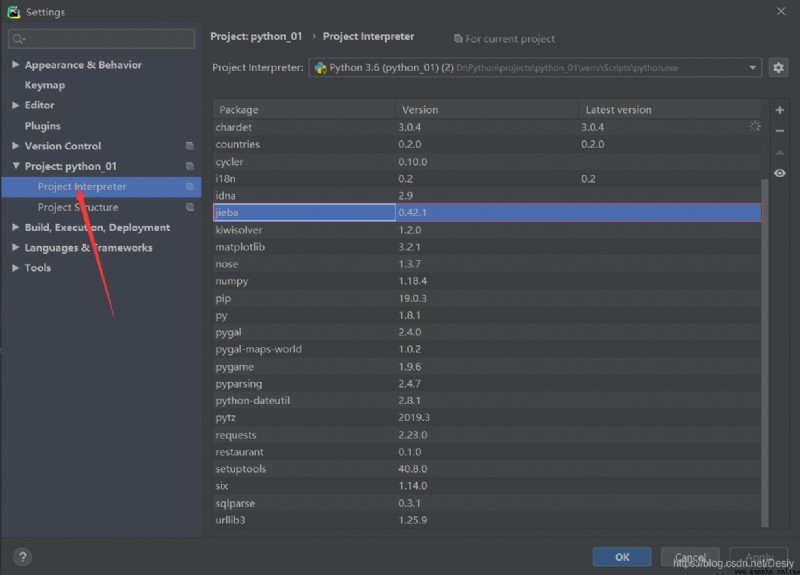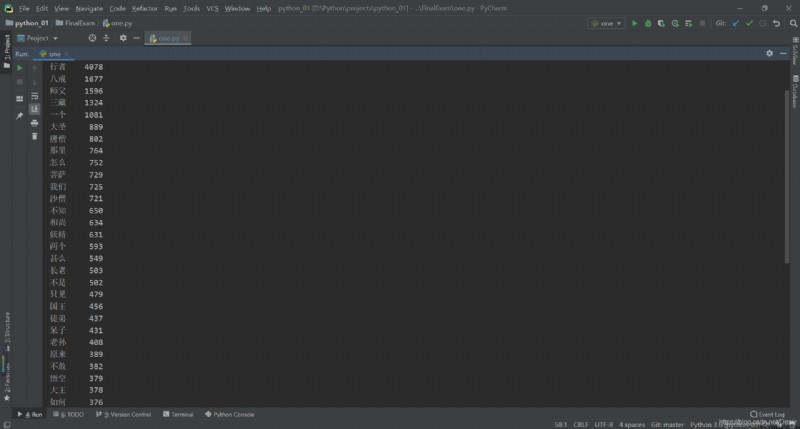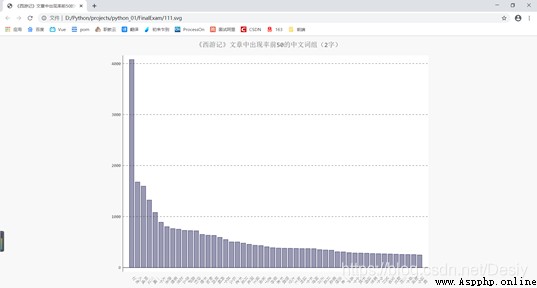首先我們需要使用python中的jieba庫;目前最好的 Python 中文分詞組件,它主要有以下 3 種特性:
具體案例:https://www.jianshu.com/p/883c2171cdb5
安裝:
使用管理員身份打開CMD:輸入pip install jieba下載成功後打開pyCharm->File->Settings->Project Interpreter,如果Package中沒有jieba,點擊右邊的“+”號添加即可。
讀取文本文件,我們在第十章學到過:with open(file) as name:** = name.read(),這裡同樣使用。不過我們需要加上編碼格式encoding=“utf-8”。
with open("D:\\Python\\projects\\python_01\\files\\JourneytotheWest.txt", encoding="gb18030") as file:
contents = file.read()
接著我們使用jieba中的方法lcut對文本進行精確分詞:導入jieba庫
import jieba
# 使用jieba中的方法lcut對文本進行精確分詞
words = jieba.lcut(contents)
再自定義一個存儲詞語及其出現次數的容器,最後遍歷。需要注意的是我們要排除單個字。
# 存儲詞語及其出現的次數
counts = {
}
for word in words:
# 單個字排除
if len(word) == 1:
continue
else:
counts[word] = counts.get(word, 0) + 1
將鍵值對轉換成list列表,且按照降序的排序順序。
items = list(counts.items())
items.sort(key=lambda x: x[1], reverse=True)
items.sort(key=lambda x: x[1], reverse=True)這個語句中的sort函數用於對原列表就行排序,如果指定參數,則使用比較函數指定的比較函數。reverse=True是降序的意思,反之False為升序。這裡的難點是key=lambda x: x[1],這個lambda是一個隱函數,後面的x: x可以自定義兩個一樣的字母,[0]按照第一維排序,[1]按照第二維排序,[2]按照第三維排序。我們這裡排序是根據該詞語出現的次數進行排序,我們輸出的結果格式是(word,count),count就是次數。
打印輸出詞頻為前50的詞語:
for i in range(50):
word, count = items[i]
txt = "{0:<5}{1:>5}".format(word, count)
print(txt)
txt = ("{0:<5}{1:>5}".format(word, count))這個是format方法的格式控制。比如:"{0}{1}".format(name,jack),這裡大括號裡的數字表示的是位置,也就是0對應的name,1對應的jack。同理,題中0對應的是word,1對應的是count。其次,冒號是引導符,後面跟的是格式控制方法。<表示左對齊,>表示右對齊,數字表示寬度。同理,題中<10表示左對齊,並占10個位置,>5表示右對齊,占5個位置。運行後報錯:UnicodeDecodeError: ‘utf-8’ codec can’t decode byte 0xa1 in position 0——這是Python 編碼中編碼解碼的問題,我這個錯誤就是‘utf-8’不能解碼位置0的那個字節(0xa1),也就是這個字節超出了utf-8的表示范圍了,我們這裡將前面打開文本文件語句中的encoding="utf-8"換成encoding="gb18030"即可。
結果:
最後就是繪圖。我們結合第十七章練習完成。練習中是從一個json文件中獲取,那麼我們可不可以直接使用上一步生成的數據來生成圖表呢?練習中我們從json文件中通過遍歷取的的值作為圖表的參數,這裡我們直接省去了json文件遍歷,直接使用數據作為圖表的參數。
定義儲存詞匯和次數的空數組,並且在將具體的數據append到空數組中:
names, dicts = [], []
for i in range(50):
word, count = items[i]
txt = "{0:<5}{1:>5}".format(word, count)
# print(txt)
names.append(word)
dicts.append(count)
可視化
my_style = LS('#333366', base_style=LCS)
chart = pygal.Bar(style=my_style, x_label_rotation=45, show_legend=False)
chart.title = '《西游記》文章中出現率前50的中文詞組(2字)'
chart.x_labels = names
chart.add('', dicts)
最後在生成圖表(svg):
chart.render_to_file('111.svg')

全部代碼:
import jieba
import pygal
from pygal.style import LightColorizedStyle as LCS, LightenStyle as LS
with open("D:\\Python\\projects\\python_01\\files\\JourneytotheWest.txt", encoding="gb18030") as file:
contents = file.read()
# 使用jieba中的方法lcut對文本進行精確分詞
words = jieba.lcut(contents)
# 存儲詞語及其出現的次數
counts = {
}
for word in words:
# 單個字排除
if len(word) == 1:
continue
else:
counts[word] = counts.get(word, 0) + 1
# 將鍵值對轉換成list列表
items = list(counts.items())
# reverse=True降序
items.sort(key=lambda x: x[1], reverse=True)
names, dicts = [], []
for i in range(50):
word, count = items[i]
txt = "{0:<5}{1:>5}".format(word, count)
# print(txt)
names.append(word)
dicts.append(count)
# 可視化
my_style = LS('#333366', base_style=LCS)
chart = pygal.Bar(style=my_style, x_label_rotation=45, show_legend=False)
chart.title = '《西游記》文章中出現率前50的中文詞組(2字)'
chart.x_labels = names
chart.add('', dicts)
chart.render_to_file('111.svg')
PS:上文提到的”第十章“”第十七章“均來自圖書《Python編程:從入門到實踐》。
西游記.txt獲取:https://gitee.com/desiy/python_01/blob/master/files/JourneytotheWest.txt